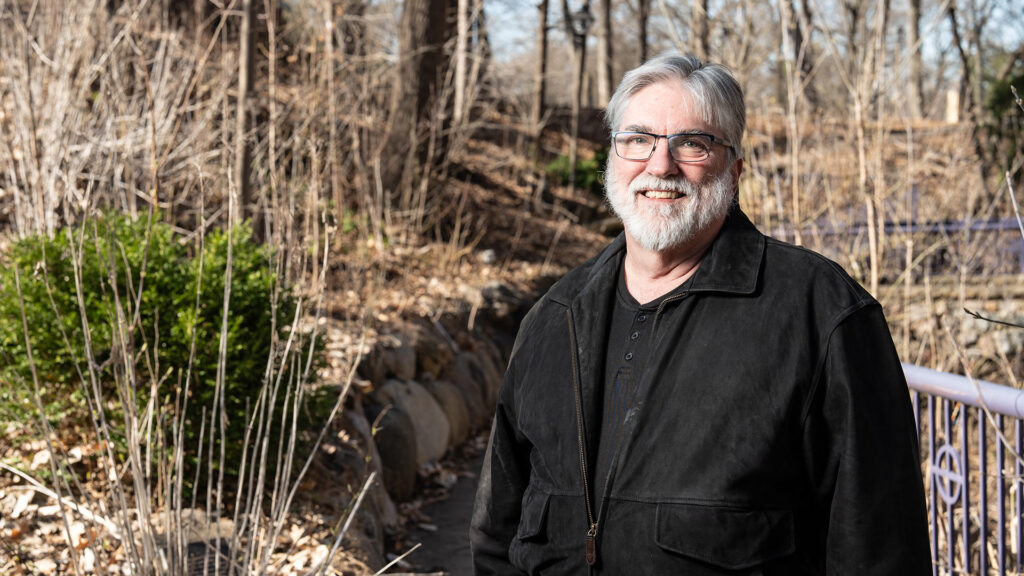There’s a phrase that says “It takes a village” – that an entire community of people helps a child achieve. For Shukrani Nangwala '21, he credits his mother, St. Thomas professors and staff, a family friend and even the university’s Urban Art Mapping Project for opening his eyes to limitless possibilities for his educational and career journey.
When he was young, Nangwala admired his mom as she pursued a doctorate. Subsequently, he began setting his own career goals as he saw her dedication to her role as an academic sociologist in Tanzania.
 Sainath Kallur / University of St. Thomas
Sainath Kallur / University of St. Thomas“Her career has been a source of inspiration for me because I watched my mom work in a field she was truly passionate to be a part of,” said Nangwala, an only child. “As a result, I now approach my career and educational aspirations by pursuing fields that are compelling to me. This is why I chose to major in marketing, with the hopes of working in advertising.”
Nangwala, who obtained his bachelor’s degree in marketing and a minor in data analytics in 2021 at St. Thomas, had his dreams come true. He is now an assistant media planner at creative agency Colle McVoy.
A photographer and video producer with an artist’s eye for detail, he said he fits in perfectly at the agency. “I can't stop talking about commercials.”
The new job was not his only dealings with TV commercials. He said "yes" when mentors suggested he star in a St. Thomas-produced commercial that is airing on local networks through May. Reaching more than 12,000 YouTube views in less than a month, the “We Are Tommies” 30-second spot focuses on the Urban Art Mapping Project led by professors from English, geography and art history.
Nangwala said those professors, Dr. Todd Lawrence, Dr. Paul Lorah and Dr. Heather Shirey, were the co-directors who brought him aboard their team that catalogued street art from numerous countries and made it accessible through an online database. Nangwala said he learned a lot from these mentors.
“I really enjoyed watching individuals like Todd, Heather and Paul go and do research about something that actually needs to be understood more. I just see them having a spirit that they want to learn more, see what they can do and even apply art into the conversation, because sometimes art gets left out,” he said. “I never really thought I'd get this much firsthand experience by being involved in art during this whole period.”
He added that the Urban Art Mapping Project “really opened my eyes to art in the streets; art that tells stories with the power to impact the world.” And Nangwala has a global perspective.
Raised in Tanzania, Nangwala spent part of his youth in Uganda with his dad (who died when Nangwala was young) and a part in Minnesota while his mom was in the Twin Cities for graduate school. He returned alone to Minneapolis-St. Paul during high school to stay with a close family friend willing to support him while his mom pursued a career assisting the Tanzanian government to improve public health infrastructure and advance women empowerment.
Some of his aspirations included using a lens to capture the stories of communities through photography and video. It first started out as a hobby to stave off homesickness, but then he landed a campus job using a camera.

“I began working for the photography department because I loved photography and my supervisor, Mark Brown (director of photography), was an awesome person. When I first began working with them, he let me take the camera and go do photography on my own free time to practice and learn.
“So having a job on campus that gave me access to these tools was amazing.”
He also cited working with leaders in Student Affairs, including Vern Klobassa, Karen Lange, Patricia Conde-Brooks and Rachel Harris. He produced videos for campus, such as the 2019 Welcome Days teaser and the singing of the St. Thomas alma mater song. He also produced an Africa Night fundraiser video.
Then George Floyd was killed. “Where I live we could see the protests begin to erupt; you could see the smoke from where my apartment was, and it was like it was something that doesn't necessarily happen in Tanzania; we're not at a point where there's lots of unrest in the community, at least,” he said.
As a Black international student from East Africa, Nangwala said the protests that followed in summer 2020 gave him a better understanding of the Black American experience. Prior to that, he said, “In the U.S., there were certain codes of conduct that I did not understand as to why everybody acts the way they do until I was able to witness an actual uprising happen in my own backyard.”
So protesters, in a way, became a part of Nangwala’s “village.”
“Watching this happen in the U.S. was a great wake-up call for me,” he said. “Coming from a low-income country to a high-income community – how people react to the disparities is very different,” he said, but one thing is similar: “Everyone wants to be given the chance to be viewed as a human.”







